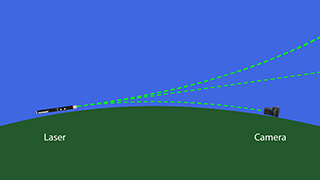Do laser tests prove the Earth is flat?
It seems like a simple, reliable test: Point a leveled laser across a long, flat surface such as a large body of water and see if it stays the same height above the surface. If the Earth is flat, the laser beam will stay the same height. If the Earth is a globe, the laser beam should get steadily higher above the surface as Earth's curvature causes the surface to drop away below it.

On a flat Earth you might expect a level laser beam to stay the same distance above the ground.

On a curved Earth you might expect a level laser beam to increase its distance above the ground.

In reality, it's not that simple. The light path depends on environmental factors.
Over the years, many tests have been conducted to determine how far into the distance it is possible to see a laser at ground level, and whether this fits best with a globe-earth or flat-earth model. Unfortunately, these tests often have wildly different results that appear to be contradictory. Some show a laser beam apparently staying at the same height, implying that the Earth is flat. Others appear to show the laser disappear below the horizon as expected in the globe-earth model.
These discrepancies can be explained by understanding two things:
- Atmospheric refraction bends light.
- Laser beams get wider the farther they travel.
These are real phenomena. Anyone can see that laser beams spread out over distance (although it's hard to measure exactly), and that refraction happens when light travels through a medium of varying density. Indeed, atmospheric refraction is a known problem in many fields. Surveyors must minimize and account for refraction. Sailors navigating by the sky avoid stars that are too close to the horizon because their positions are distorted by refraction.
It is therefore surprising how many laser level experiments do not account for these issues. If you watch a long-range laser experiment that doesn't even mention atmospheric refraction or beam divergence, the experiment is incomplete and it's safe to assume the experimenter doesn't really know how to conduct this type of research.
Light rays are usually bent towards the surface of a large body of water. This is because the water tends to cool the air close to it, creating a temperature and density gradient close to the surface. This refracts light waves (including the laser beam) down. Importantly, the amount of refraction varies depending on environmental conditions. In some cases, refraction can even make the Earth's surface appear curved in a concave direction. Figuring out exactly how much refraction is occurring isn't easy, but there are calculation tools available to help.
The end result is this: As light rays get bent down, they stay closer to the curved Earth's surface and can remain visible for some distance over the horizon. If there's just the right amount of refraction, objects would also appear to stay exactly the same height above the surface.
By the way, many flat-earth experimenters make a point of positioning the laser close to the ground or water surface, as if this is a good thing. It isn't, because this is exactly where refraction has the most effect (the temperature gradient tends to be greatest near the surface). It would be better to position both the laser and the observer several metres above the surface.
In addition to atmospheric refraction, there is the problem that laser beams diverge (get wider) over long distances. If you're looking at a laser beam from several kilometres away, how do you know if you're looking at the centre of the beam? It's not as easy to tell as you might think. If you see an experiment that doesn't address this problem, it's not a valid test.
Ironically, the easiest way to solve the beam divergence problem is to not use a laser at all. The experiment's goal is to see if a horizontal ray of light stays the same height above the Earth's surface. You can do this by simply looking at an object—it doesn't need to be a laser beam.
This is actually an old experiment, going back at least to the famous Bedford Level experiment in the 19th Century. Of course they didn't use lasers then, but instead used flag poles placed at a consistent height over several kilometres. The Bedford Level experiment, like any well-conducted similar experiment today, shows that light rays are directed downwards, enabling things to be seen over the horizon as if the surface between them was flat.
How to do a flat-earth laser experiment correctly:
- Have at least one independent observer who is qualified to critique the experiment.
- Instead of using a laser, use any object that you can mount at a consistent height and see clearly from a distance. A flag pole is a good choice.
- Now get another one. This is an important improvement to the original experiment: Having at least two objects at the same height but varying distances for the observer to line up. For example, have one flag pole at 5 km and another at 10 km distance. This allows you to see if there's a "bump" in the line of sight that is expected in the globe-earth model.
- Account for atmospheric refraction. This is probably the hardest part. To allow for varying conditions, you should repeat the experiment many times at different times of the day, night and year. Also try completely different locations.
Helpful video: Why Flat Earth Laser Tests are Misleading Nonsense
